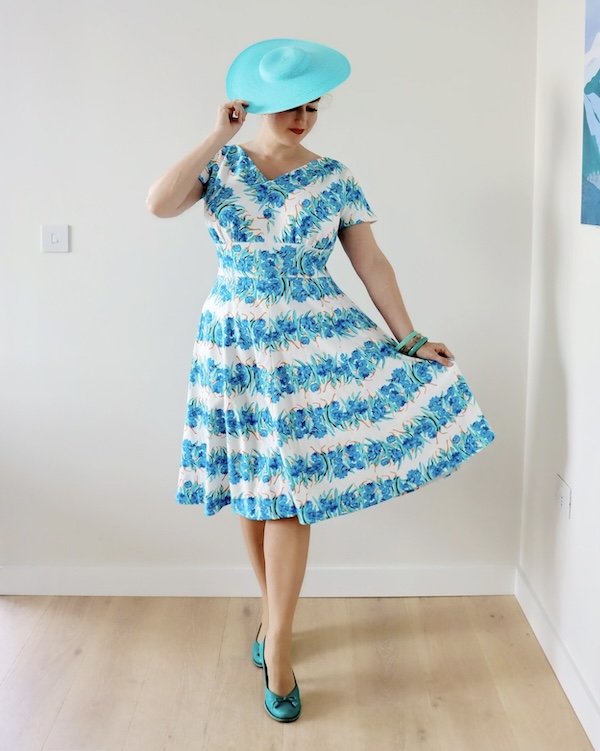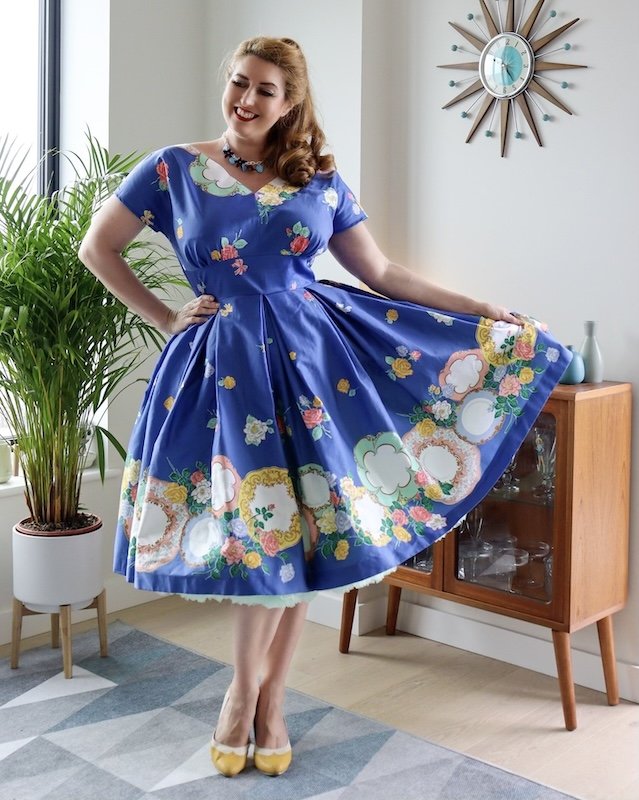This post was originally published in 2020 and has been revised and updated for 2024
Continuing my series on print-on-demand fabric services, today I’m reviewing the original trailblazer on the digital fabric printing scene, Spoonflower. I have been a Spoonflower designer for many years now, and you can find all the prints featured in this article - and many more - in my Spoonflower shop.
US-based Spoonflower has been in the digital fabric printing game since 2008 and is the market leader in this space. With a commitment to promoting sustainability and eco-friendly processes, coupled with an emphasis on supporting independent artists, Spoonflower is now at the centre of a huge community of creatives.
Fabric Options
Spoonflower has over 25 fabric options to choose from. As with other services, you can order a sample pack for a nominal fee and free standard shipping.
With so many options to choose from, I often get asked which Spoonflower fabrics I recommend for vintage dressmaking. The main garment fabrics are as follows:
Organic cotton sateen - a nice substantial-feeling, soft sateen with a subtle sheen. The sateen has a bit of body so lends itself to 1950s dresses, skirts, shorts/playsuits and structured tops. I use this one the most, especially for border print skirts. The fabric feels quite stiff when it arrives, especially in darker colours, but it softens up beautifully after a few washes (it won’t be noticeable after one wash, but you’ll feel the difference after a few wears)
Poly crepe de chine - lightweight, floaty and semi-sheer, almost a chiffon. Works well for some 1930s and 40s styles, like the dress shown here. Because it’s semi-sheer, you may need to consider a lining (and even an interlining in lighter colours for greater opacity). The two poly crepe de chine dresses shown on this page are fully lined in lightweight cupro lining.
Cotton poplin - a high thread count cotton with a crisp, smooth feel, good for blouses and dresses. I made a dress in the poplin some years ago, and although it was a bit stiff initially, it softened up with repeated laundering.
Organic cotton knit - I accidentally ordered a length of this when I meant to order the sateen. I decided to make it up into a dress since I had it, and it’s become one of my wardrobe staples! It’s a stable knit, so can be used for patterns designed for wovens with only fairly minor adjustment (the dress below was made from the Mimosa dress pattern; I sized down and took in the side seams).
Petal signature cotton - primarily intended quilting applications, this is a workaday basic cotton. It works well for casual shirts, dresses and playsuits, but I personally prefer the sateen for garment sewing.
Cotton lawn - very lightweight cotton, suitable for blouses (I’ve never used this fabric option)
Pricing
Spoonflower was the original service to make digital fabric printing affordable for the everyday consumer, and remains competitive in its pricing. The prices below are standard pricing before discounts:
Petal signature cotton: $20 per yard / 42” wide
Cotton poplin: $22 per yard / 42” wide
Cotton lawn: $24 per yard / 54” wide
Poly crepe de chine: $24 per yard / 52” wide
Organic cotton sateen: $32 per yard / 56” wide
Organic cotton knit: $29 per yard / 56” wide
Spoonflower offers a 10% ‘designer discount’ if you place an order of your own design. There are also bulk discounts available on orders over 20 yards.
Order process and delivery
You can select from designs made available by other users, or upload your own. Unlike some other services, the designer specifies the DPI for each pattern in their shop, so you can’t customise the scale of other users’ designs. If you’re uploading your own design, however, you have complete freedom with how it’s printed.
US orders ship from Durham, NC, while EU orders are printed and processed at their factory in Berlin, Germany (which means no customs fees for the UK!).
Shipping costs are calculated based on the weight of the order. Standard orders are printed and shipped within 14-16 days, so you can expect to wait up to 3 weeks for your fabric to arrive. They do have expedited/rush order options, but the prices are steep.
Colour and print quality
The pigment inks used in Spoonflower’s printing process sit on the surface of the fabric. This is a very eco-friendly process as it eliminates waste ink and uses very little water. The downside is that dark colours require quite a heavy layer of the pigment, so this tends to stiffen the cotton fabrics. This eases with repeated washing, although most of my fabrics are not on very dark colour backgrounds.
I think Spoonflower’s printing skews cool, especially with pinks; I often find myself needing to warm up the colours in my designs after I get my swatches back. The DPI isn’t as high as some other services, so some very fine detail may not come out and the lines may not be razor-sharp, but that’s not a negative for me - I rely on that very tiny bit of dye bleed to give it a more authentically vintage feel.
Selling your designs
As with other print-on-demand services, there is a requirement to purchase a swatch of your design before you can list it for sale in the Spoonflower marketplace. Individual swatches are priced at $5 with free shipping, but if you’re ordering multiple swatches you can order at a discounted rate by creating a Sampler or using their Fill-A-Yard feature.
Once you have purchased your swatch, you can make any revisions you need and upload a revised image file if necessary. You can then opt into selling your design (it isn’t automatic; all designs are private by default, you have to tick the box to make them public and sell).
Designers receive 10% commission on sales of their designs. Designers with large monthly sales volumes qualify for a commission bonus of between 1-5%.
Spoonflower also provides resources to designers, with guides to every topic from how to create a design to marketing your art. The regular design challenges can help get your artistic juices flowing, and is also a great way to get your work noticed (although with hundreds of entries, competition is stiff!).
Verdict
As a long-time Spoonflower user and member of the community, I will continue to patronise the site.












